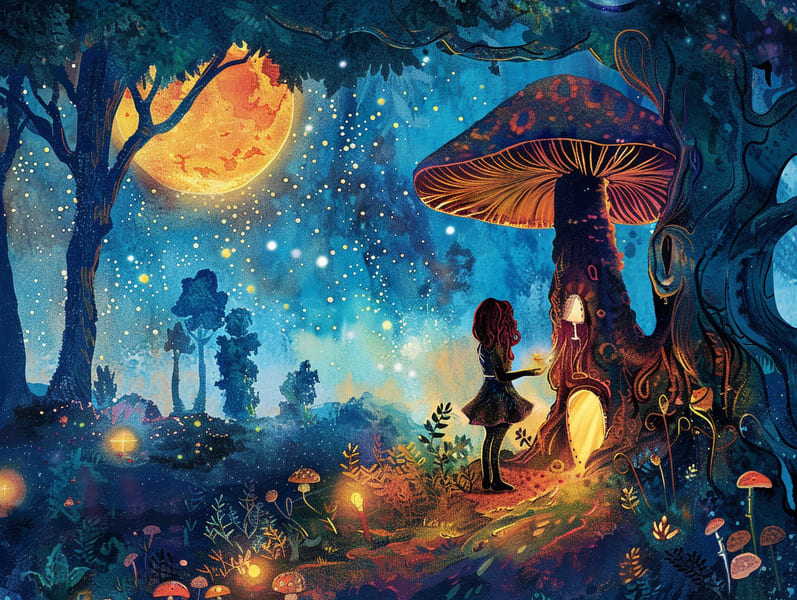
Timeless fairy tales have long histories. These narratives have been relayed from one generation to the next ages before they were ever documented. They developed from a variety of cultures, including Western traditions. They were initially narrated among grown-ups, often carrying themes and messages mirroring the societal norms and beliefs of the time.
Jacob and Wilhelm Grimm, Jacob and Wilhelm, were among the first to gather and publish many of these beloved fairy tales. Their compilation, "Grimm's Fairy Stories," included stories like "The Story of Cinderella," "The Bread Crumb Trail," and "Snow White," which have since become classics in the world of timeless fairy tales. Similarly, H. C. Andersen's whimsical narratives, such as "The Mermaid," and "The Ugly Duckling," have gained the love worldwide, guaranteeing their place in the pantheon of beloved fairy tales.
Though they are centuries old, fairy tales remain as applicable as ever, especially as children's night stories. These fantastical tales are now available in different formats, including beautifully illustrated books, charming animations, and digital fairy tales.
Their enduring popularity can be attributed to several delightful features:
Important Morals: Traditional fairy tales often share important moral lessons. Tales like "The Wolf and the Liar" teach the importance of being truthful, while "The Hare and the Tortoise" demonstrate the values of persistence and meekness. These tales offer children clear distinctions between truth and falsehood, shaping their moral compass in a mild yet impactful way.
Empathy and Awareness: Timeless fairy tales frequently involve heroines facing challenges and problems, inspiring young readers to comprehend with their struggles and root for their triumphs. For instance, "The Tale of Beauty and the Beast" highlights the value of looking deeper to understand the inner being of a being, cultivating empathy and appreciation.
Cultural Recognition: Many classic fairy tales are rich in the cultural contexts from which they developed. Understanding these narratives can provide fascinating glimpses into different historical contexts, fostering a sense of world awareness and appreciation.
Fantasy and Imagination: The magical elements in classic fairy tales—magical beings—revitalize children’s creativity. These fairy tales take readers to fantasy realms, kindling imaginative ideas and a sense of curiosity that persists a lifetime.
Traditional fairy tales are not only bewitching but also instructive. They function as fantastical tools in advancing various mental and emotional abilities in the young. When timeless fairy tales are told out loud, they improve linguistic abilities by offering new phrases and complex sentence structures. This practice also promotes listening abilities and mindfulness, as young readers track the narrative, ready to see what happens next.
Furthermore, talking about the themes and characters of old fairy tales can enhance cognitive skills and problem-solving abilities. Young readers are led to notice patterns, forecast, and know cause and effect. These conversations also support kids verbalize their thoughts and feelings, nurturing their emotional intelligence.
In today’s electronic age, the prevalence of online fairy tales has made these fairy tales more within reach than ever. Digital sites and digital apps give large libraries of old fairy tales that can be perused or listened on anytime, anywhere. Fairy tales narrated are particularly common, offering an enjoyable way for young readers to savor these mesmerizing stories. Audio stories and read-out-loud videos bring characters and settings to life, often accompanied by fantastical background sounds and melodies that enrich the narrative adventure.
The unfading fascination check here of timeless fairy tales lies in their ability to adapt to today's society while holding onto their fundamental ideas. Contemporary updates of these stories often introduce more inclusive protagonists and modern settings, making them understandable to today’s audience. However, the basic principles of braveness, compassion, and fairness remain unchanged, continuing to affect kids of all ages.
Classic fairy tales also offer a sense of ease and knowability. They feature a well-ordered narrative with a plain beginning, middle, and end, often closing with the conclusion of conflicts and the triumph of justice over injustice. This foreseeability can be reassuring for the young, extending a sense of firmness in an constantly changing world.
Old fairy tales continue to spellbind and edify new generations, maintaining their charm and meaningfulness in modern society. As children's bedtime stories, they distribute a perfect blend of fascination and comprehension, enhancing moral values, empathy, and creativity. The presence of online storybooks and the well-liked nature of fairy tales recited warrant that these ancient fairy tales remain available to new generations.
By retaining and disseminating these fairy tales, we continue to esteem the rich tapestry of lore and cultural heritage. Whether you are delving into a gorgeously illustrated book, seeing a internet collection, or listening through an audio story, the majesty of classic fairy tales is always within reach. These fairy tales illustrate of the everlasting ability of narratives and its ability to bind us across time and space.
Even if you are perusing a richly illustrated book, exploring a cyber library, or listening to an read-aloud book, the attraction of children's fairy tales is always within reach.
These tales illustrate of the everlasting nature of storytelling and its ability to link us across time and space, making a tie that captivates and teaches alike.